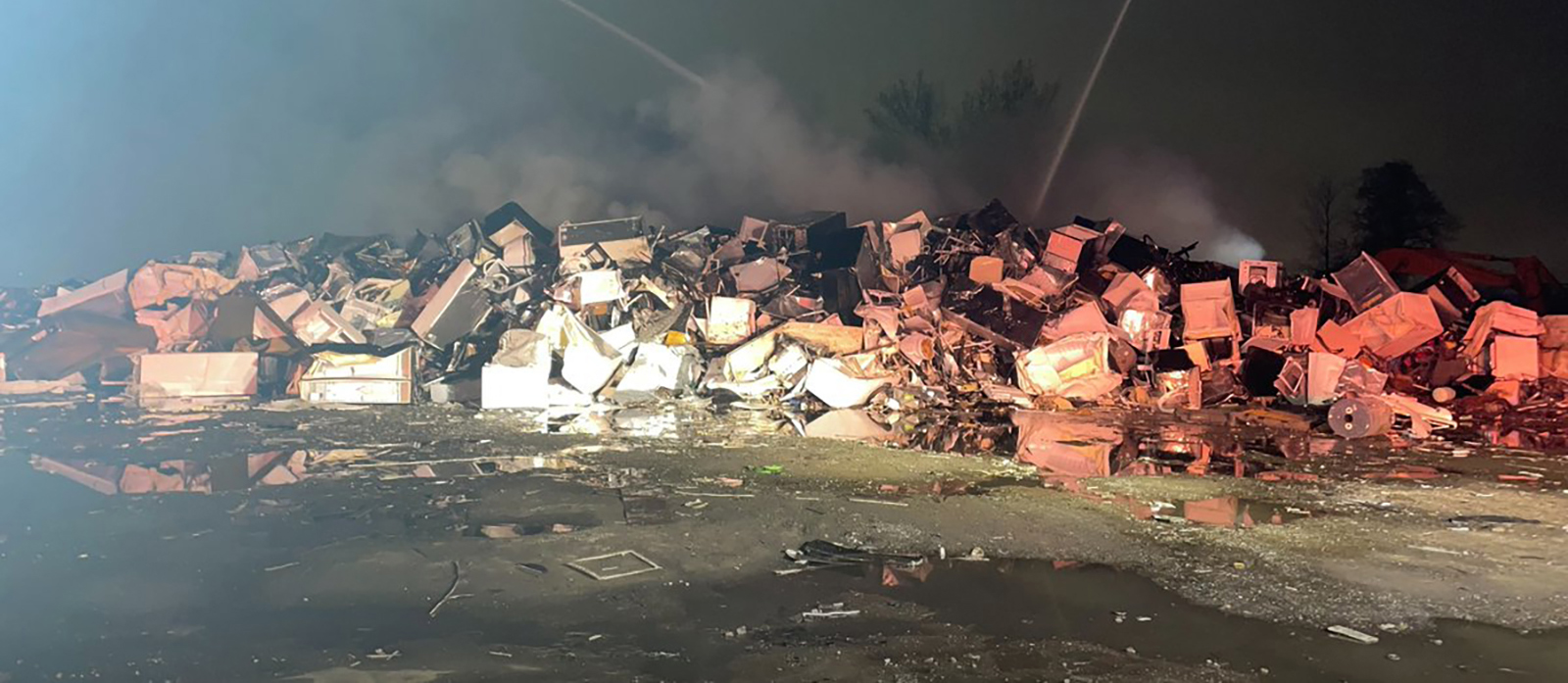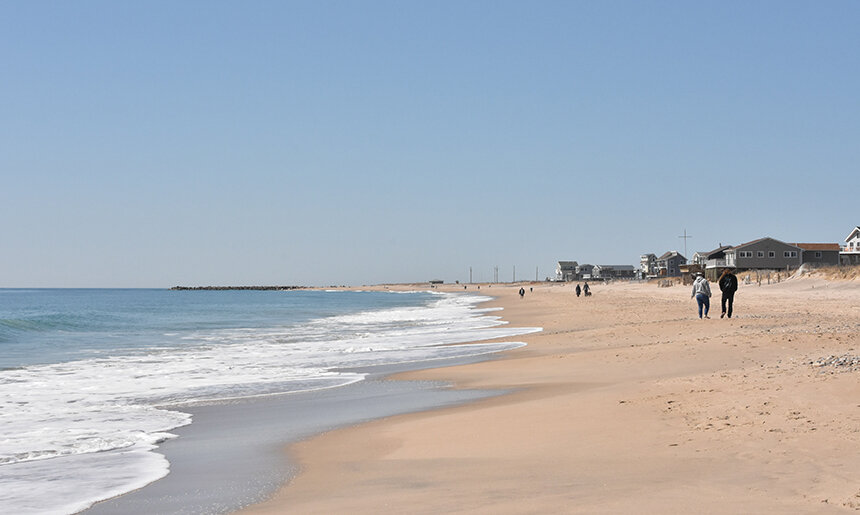Swansea Residents Endure Decade of Brown Drinking Water
December 1, 2019
SWANSEA, Mass. — For all the tap water the five women waste waiting for the flow to clear, they likely buy an equal amount of bottled water, to brush their teeth, make ice cubes, hydrate their pets, cook, and bathe a toddler.
The five are members of a group called Expect Better Swansea, which consists of nearly 20 residents who are concerned about the quality of the town’s drinking water.
For about a decade, they said, they have been dealing with recurring episodes of manganese-tainted brown water flowing from their faucets and other issues, such as high levels of trihalomethanes (THMs) — a group of chemicals linked to cancer that are formed when chlorine, used to control microbial contaminants in drinking water, reacts with naturally occurring organic and inorganic matter.
Expect Better Swansea members say the town’s brown-water problem coincides with the construction of a desalination plant nearly 10 years ago. The facility takes brackish water from the Palmer River — routinely impaired by elevated levels of fecal indicator bacteria, total suspended solids, and nutrients such as nitrogen and phosphorus — desalinates it, and returns the salt back to the river.
“It is a nightmare … for residents who are receiving heavily chlorinated, often brown, manganese-tainted water, and for the river,” said Lisa Martelly, a Raymond Allard Boulevard resident who has lived in Swansea for 30 years.
Swansea’s water contains high amounts of manganese and iron because the minerals cling to the inside of the town’s 124 miles of water mains and pipes. System disruptions, such as the operation of the desalination plant or hydrant flushing, scrape this buildup off the cast-iron walls of pipe that range from 6-12 inches in diameter.
ecoRI News met with four of the women in early November at Martelly’s home. They said they regularly empty their hot-water heaters to keep them from “getting wrecked,” appliances have been damaged, and laundry has been ruined by the town’s manganese-tainted water.
Martelly noted that her and her husband’s annual water bill is about $280 — the Swansea Water District charges $2.50 per 1,000 gallons — and they pay some $1,500 annually in water district taxes. She said they spend another $90 or so a month on bottled water.
All four of the women routinely buy bottled water — much more than they normally would if their tap water didn’t consistently run brown, they said — and they have all invested in filtration systems and the replacement filters they require.
One of the women, Betsy Waring, also a resident of the town’s Ocean Grove neighborhood, has been saving discolored water in bottles by date. She brought five bottles to the Nov. 8 meeting. Manganese in her home tap water has tested as high 0.24 and 0.21 milligrams per liter. The federal secondary standard is 0.05 milligrams per liter. She shared a video of brown water flowing from her kitchen faucet.
“You learn a new lifestyle,” said one of the women who didn’t want to be identified. “You turn the cold water on and let it run for a few minutes before you do anything. I can’t imagine the people who have front-loaders because you can’t really see the water going in. I have a top-loader so I can let the water run and see it’s not brown. I actually have a cup and I will hold it up so I know, I’m hoping, that it’s safe to do the whole batch, because you could get brown water in the rinse cycle.”
The fifth local resident ecoRI News spoke with for this story, Amelia Sloane, asked the town’s Board of Water Commissioners to pay for the installation of a water filtration system in her home. She requested the system because her 3-year-old daughter has a brain condition (chiari malformation) that can affect her immune system.
At an August Board of Water Commissioners meeting, Sloane presented the board’s three members with a letter from her daughter’s pediatrician noting that a filter would be a positive step for the child’s health. Sloane told the board that the water quality at her home fluctuates and that this disruption in quality impacts her daughter’s behavior.
The Board of Water Commissioners eventually denied the request, not wanting to set a precedent for installing water filtration systems for the district’s other 6,299 customers. Board members also weren’t convinced that a filtration system would necessarily correct the problem.
Sloane told ecoRI News during an interview Nov. 14 at a local coffee shop that her situation is different because it concerns a medical necessity for her young child. The kindergarten teacher noted that headaches, loss of appetite, and irritability are among her daughter’s symptoms that are aggravated by the fluctuating water quality. She said the water issue has placed additional stress on the family, noting that she and her husband, a deli clerk, don’t have the financial means to pay for a filtration system.
“Having a child with a rare disease puts enough strain on you to keep them safe and healthy that the last thing you need to worry about is what color the water is coming out of your faucet or what it is going to smell like,” Sloane said. “It takes a lot to ask for help, and having asked and made yourself vulnerable … only to be told, ‘Well I’m sorry for your problems but we are not going to do anything about them,’ really kicks you in the gut.”
The Sloanes were among the households that agreed to have the Swansea Water District test water from outside faucets. During an 18-day period this past summer, Sloane’s home on Oban Way tested above the 0.05-milligrams-per-liter secondary standard 12 times, with an average of 0.08. The high was measured at 0.16, with a low of 0.01.
“She’s already compromised enough that I don’t need to add any more chemical variations into her body,” Sloane said. “She’s not able to tolerate changes in water quality … what wouldn’t affect most of us is magnified monumentally for her. Her body can’t adapt to the continuous change.”
In late August, the Sloanes moved in with Amelia’s grandmother. Her grandmother’s house, 2 miles from their home on Oban Way, has clearer water. The town has been addressing the situation, so the manganese/iron problem impacts neighborhoods differently. Since the move, the Sloanes no longer have to take their laundry to an out-of-town laundromat.
Sloane said her daughter now refers to their home as “our brown water house.”
Manganese is a naturally occurring mineral that is present in soils, sediment, and rocks. It’s a beneficial mineral found in many grains, beans, teas, and vegetables, such as spinach, and in multivitamins.
Both the Environmental Protection Agency (EPA) and Massachusetts Department of Environmental Protection (DEP) list manganese as a secondary contaminant because of aesthetic concerns, including unacceptable taste and odor, staining of fixtures, and dark, cloudy water at levels greater than 0.05 milligrams per liter. It can’t be boiled away.

Manganese is necessary for normal immune system function, digestion, and bone strength. At elevated levels, manganese can produce neurological impacts, with some variation in sensitivity between individuals, according to DEP.
The Swansea Water District has asked residents with discolored water to flush their system from a faucet that doesn’t have a screen, such as an outside spigot.
The residents ecoRI News spoke with said this solution doesn’t always work. They said it also creates some inconvenience when it’s time to shower, do laundry, or wash the dishes. They noted it’s a difficult task when it’s below freezing outside. One of the women said she once ran the water for an hour and the brown color never disappeared.
Board of Water Commissioners chairman James Hall has said at public meetings that the town’s brown water constitutes a nuisance and not a hazard. He has noted that the water isn’t toxic and doesn’t have bacteria or lead in it.
This past summer, in an email to the Board of Selectmen chairman, Hall called the residents who have expressed concern about Swansea’s water quality “village idiots.” Hall’s email was shared on the Drain the Swansea Water Department Facebook page.
When Jeffrey Sutherland took the Swansea Water District superintendent’s job two years ago this February, he knew dealing with the town’s discolored water issue needed to be a top priority. He said the water is brown because of corrosion control in the pipes, mandated by the EPA, to prevent lead and copper from leaching into drinking water. This process softens the materials, such as manganese and iron, that cling to water pipes.
There are high concentrations of both manganese and iron in New England’s soil and groundwater, so Swansea isn’t alone in dealing with the discoloration of water caused by the presence of these minerals. The towns of Dighton, Norton, and Scituate are among the Massachusetts municipalities also dealing with this issue.
“I’m not going to downplay it and say that it’s not harmful … anything in high concentrations is bad for you,” Sutherland said. “What they try to do when they set these standards for water is they try to set them so low that they don’t want water to affect your dietary income and that’s how it should be. Water should be as pure as we can get it.”
Sutherland said the Swansea Water District has undertaken several initiatives to address the problem, including building facilities that treat for iron and manganese. He said the town still has one well, out of 12, that has elevated levels of manganese.
Another fix that has already been done three times is a technique called ice pigging — an ice slurry, at a temperate of about 25 degrees Fahrenheit, thanks to the addition of food-grade salt, is pumped into water mains through fire hydrants and forced along under high pressure to remove sediment and other unwanted deposits that have collected on pipes.
This process is a cheaper alternative to replacing the town’s 70-year-old cast-iron/cement-lined pipes, which Sutherland said are in otherwise great condition. The cost to replace a water main is between $150 and $200 a foot (about $1 million per mile), while ice pigging costs $4 to $5 a foot (about $20,000 per mile), according to Sutherland.
He said the district’s ice-pigging efforts have been successful, scraping at least 336 pounds of material from some 8 miles of pipe. (The district hasn’t yet received the amount of material scraped during the third ice pigging.)
The pigged water is collected in another truck, so the manganese- and iron-tainted water being forced out isn’t dumped indiscriminately.
The district also has been conducting coordinated, high-velocity flushing of the system through fire hydrants at a clip of 700 to 1,000 gallons a minute for 5-10 minutes. The district is scheduled to conduct more ice pigging and hydrant flushing in spring and fall 2020.
Sutherland said the desalination plant does contribute to the brown-water problem, because when the facility is pushing water through the system at about 1,000 gallons a minute it causes a major distribution that scrapes manganese and other pipe debris into the water flow.
While Expect Better Swansea wants the desalination plant shut down, the Swansea Water District and town officials don’t believe that is best course of action. Sutherland said the facility’s problems are relatively minor compared to some of the other issues the district is addressing.
The desalination plant has been operating under an administrative consent order from the EPA, because of excessive salt levels being returned to the Palmer River. A report done earlier this year by a Maryland-based engineering firm found the facility was operating inefficiently and offered several options on how to improve its performance.
The $20 million facility — built in 2010 to handle the town’s increasing demand for water, especially in the summer — handles some 2.2 million gallons of drinking water daily. The facility opened in 2013 and wasn’t operating consistently until 2016.
As for the trihalomethanes, DEP issued a consent order to the Swansea Water District last October, citing high levels of THMs.
The THMs group includes four chemicals: bromodichloromethane, bromoform, chloroform, and dibromochloromethane. The Environmental Working Group’s latest update on Swansea’s water found THMs at 353 times above the organizations health guidelines, at 52.9 parts per billion (ppb). The EWG’s health guideline of 0.15 parts ppb was defined in a peer-reviewed scientific study.
The legal federal limit is 80 ppb. The national average is 30.1 ppb, and the Massachusetts average is 25.5 ppb, according to the EWG.
The Swansea Water District was required to submit an engineering report that outlined recommended actions, such as collecting monthly samples and creating a better flushing program. Sutherland said the district is complying with the order and has a plan to address the issue.
Much of the town’s THMs problem, Sutherland said, is being caused by water stagnating in the district’s 750,000-gallon tank on Sharps Lot Road. This spring, the district plans to install an aerator in the old tank to keep the water circulating.
He said the Swansea Water District is also working to create a system that better notifies the public about major distributions in the system, scheduled hydrant flushings, and other important notices. He said he hopes this revamped system will include robocalls.
Expect Better Swansea is also petitioning the town to change the annual election for the Board of Water Commissioners to coincide with the town’s annual election. The annual election of a new water commissioner is held two weeks after the town’s regular May election, for two hours, 6-8 p.m., at the high school.




Its really great to have brown water come out of your faucet on Thanksgiving day. Only in Swansea is that acceptable. I have been to the water department several times during the last 10 years. Excuses only go so far.
If Mr. Hall resorts to name calling instead of doing his job he shouldn’t be chairman of the water board!